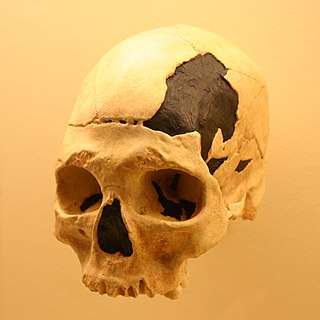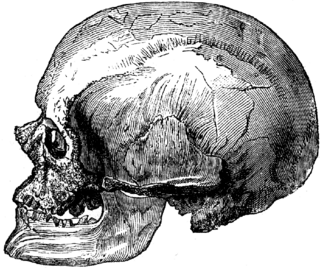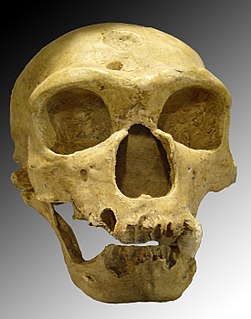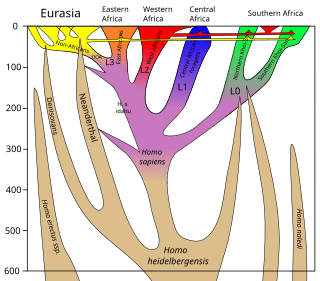Related Research Articles

Svante Pääbo is a Swedish geneticist specialising in the field of evolutionary genetics. As one of the founders of paleogenetics, he has worked extensively on the Neanderthal genome. Since 1997, he has been director of the Department of Genetics at the Max Planck Institute for Evolutionary Anthropology in Leipzig, Germany.

In taxonomy, Homo sapiens is the only extant human species. The name is Latin for "wise man" and was introduced in 1758 by Carl Linnaeus.
Neanderthal extinction began around 40,000 years ago in the Paleolithic Europe, after anatomically modern humans had reached the continent. This date, which is based on research published in Nature in 2014, is much earlier than previous estimates, and it was established through improved radio carbon dating methods analyzing 40 sites from Spain to Russia. The survey did not include sites in Asia, where Neanderthals may have survived longer. Evidence for continued Neanderthal presence in the Iberian Peninsula at 37,000 years ago was published in 2017.
The Neanderthal genome project is an effort of a group of scientists to sequence the Neanderthal genome, founded in July 2006.

Peștera cu Oase is a system of 12 karstic galleries and chambers located near the city Anina, in the Caraș-Severin county, southwestern Romania, where some of the oldest European early modern human (EEMH) remains, between 37,000 and 42,000 years old, have been found.

Early human migrations are the earliest migrations and expansions of archaic and modern humans across continents beginning 2 million years ago with the out of Africa migration of Homo erectus. This initial migration was followed by other archaic humans including H. heidelbergensis, which lived around 500,000 years ago and was the likely ancestor of both Denisovans and Neanderthals. Early hominids were said to have "crossed land bridges that were eventually covered in water".

European early modern humans (EEMH) in the context of the Upper Paleolithic in Europe refers to the early presence of anatomically modern humans in Europe. The term "early modern" is usually taken to include fossils of the Bohunician, Ahmarian, Aurignacian, Gravettian, Solutrean and Magdalenian, extending throughout the Last Glacial Maximum (LGM), covering the period of roughly 48,000 to 15,000 years ago, usually referred to as the Cro-Magnon. The earliest sites in Europe dated 48,000 years ago are Riparo Mochi (Italy), Geissenklösterle (Germany), and Isturitz (France) The upper limit of 15,000 marks the transition to the European Mesolithic, depending on the region also given in the range of 12,000 to 10,000 years ago.

In paleoanthropology, the recent African origin of modern humans, also called the "Out of Africa" theory (OOA), recent single-origin hypothesis (RSOH), replacement hypothesis, or recent African origin model (RAO), is the dominant model of the geographic origin and early migration of anatomically modern humans.

The multiregional hypothesis, multiregional evolution (MRE), or polycentric hypothesis is a scientific model that provides an alternative explanation to the more widely accepted "Out of Africa" model of monogenesis for the pattern of human evolution.

The Denisovans or Denisova hominins(di-NEE-sə-və) are an extinct species or subspecies of archaic humans in the genus Homo. Pending its taxonomic status, it currently carries temporary species or subspecies names Homo denisova, Homo altaiensis, Homo sapiens denisova, or Homo sp. Altai. In 2010, scientists announced the discovery of an undated finger bone fragment of a juvenile female found in the Denisova Cave in the Altai Mountains in Siberia, a cave that has also been inhabited by Neanderthals and modern humans. The mitochondrial DNA (mtDNA) of the finger bone showed it to be genetically distinct from Neanderthals and modern humans. The nuclear genome from this specimen suggested that Denisovans shared a common origin with Neanderthals, that they ranged from Siberia to Southeast Asia, and that they lived among and interbred with the ancestors of some modern humans, with about 3% to 5% of the DNA of Melanesians and Aboriginal Australians and around 6% in Papuans deriving from Denisovans. Several additional specimens were subsequently discovered and characterized.

Neanderthals are an extinct species or subspecies of archaic humans in the genus Homo, who lived within Eurasia from circa 400,000 until 40,000 years ago.

Neanderthal anatomy differed from modern humans in that they had a more robust build and distinctive morphological features, especially on the cranium, which gradually accumulated more derived aspects, particularly in certain isolated geographic regions.

There is evidence for interbreeding between archaic and modern humans during the Middle Paleolithic and early Upper Paleolithic. The interbreeding happened in several independent events that included Neanderthals, Denisovans, as well as several unidentified hominins.
This page lists major archaeological events of 2015.

Manot Cave is a cave in Western Galilee, Israel, discovered in 2008. It is notable for the discovery of a skull that belongs to a modern human, which is estimated to be 54,700 years old. The partial skull was discovered at the beginning of the cave's exploration in 2008. Its significance was realised after detailed scientific analysis, and was first published in an online edition of Nature on 28 January 2015. This age implies that the specimen is the oldest known human outside Africa, and is evidence that modern humans lived side-by-side with Neanderthals. The cave is also noted for its "impressive archaeological record of flint and bone artefacts". Geologically, it is an "active stalactite cave".
Manot 1 is a fossil specimen designated to a skullcap that represents an archaic modern human discovered in Manot Cave, Western Galilee, Israel. It was discovered in 2008 and the scientific description was published in 2015. Radiometric dating indicates that it is about 54,700 years old, and thought to be directly ancestral to the Upper Paleolithic populations of the Levant and Europe.

Southwest Asian Neanderthals are Neanderthals that lived in Turkey, Lebanon, Israel, Syria, Iraq, and Iran, the southernmost expanse of their known range. Although their arrival in Asia is not well-dated, early Neanderthals occupied the region apparently until about 100,000 years ago. At this time, Homo sapiens seems to have replaced them in one of the first anatomically modern expansions out of Africa. In their turn, starting around 80,000 years ago, Neanderthals seem to have replaced Homo sapiens in Southwest Asia. They inhabited the region until about 55,000 years ago.

Kebara 2 is a 60,000 year-old Levantine Neanderthal mid-body male skeleton. It was discovered in 1983 by Ofer Bar-Yosef, Baruch Arensburg, and Bernard Vandermeersch in a Mousterian layer of Kebara Cave, Israel. To the excavators, its disposition suggested it had been deliberately buried, though like every other putative Middle Palaeolithic intentional burial, this has been questioned.
Genetic studies on Neanderthal ancient DNA became possible in the late 1990s. The Neanderthal genome project, established in 2006, presented the first fully sequenced Neanderthal genome in 2013.
References
- ↑ Hershkovitz, Israel; Marder, Ofer; Ayalon, Avner; Bar-Matthews, Miryam; Yasur, Gal; Boaretto, Elisabetta; Caracuta, Valentina; Alex, Bridget; Frumkin, Amos; Goder-Goldberger, Mae; Gunz, Philipp; Holloway, Ralph L; Latimer, Bruce; Lavi, Ron; Matthews, Alan; Slon, Viviane; Mayer, Daniella Bar-Yosef; Berna, Francesco; Bar-Oz, Guy; Yeshurun, Reuven; May, Hila; Hans, Mark G; Weber, Gerhard W; Barzilai, Omry (2015). "Levantine cranium from Manot Cave (Israel) foreshadows the first European modern humans". Nature. 520 (7546): 216–9. doi:10.1038/nature14134. PMID 25629628.
- ↑ Nowaczewska, Wioletta (2011). "Are Homo sapiens nonsupranuchal fossa and neanderthal suprainiac fossa convergent traits?". American Journal of Physical Anthropology. 144 (4): 552–63. doi:10.1002/ajpa.21437. PMID 21404232.
